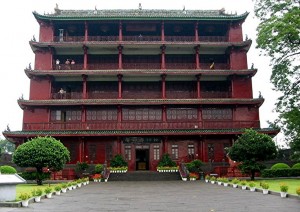Zhenhai Tower is one of the landmark buildings of Guangzhou and serves as a National Cultural Relic Protection Unit. The tower is 25 meters high and oblong in shape. The walls of the first two floors were made of red sandstone but the others were made of brick. Over the years, Zhenhai Tower has been destroyed and rebuilt five times. The existing tower was reconstructed based on one with a timber frame which stood in 1928. In 1929, Zhenhai Tower was turned into Guangzhou Municipal Museum. In 1950, it was renamed Guangzhou Museum. It displays the records of the development of Guangzhou throughout the past 2,000 years sorted according to dynasty. Welcome to Guangdong Museum when you participate in Canton Fair 2013 .

The tower is also named as Guangzhou Museum which shows the changing and development of Guangzhou’s culture, customs and the city itself through the display of ten thousand cultural relics, pictures and historical data of Guangzhou. On its west seats a stele corridor which shows the stele carvings of the past dynasties of China and 12 Ancient Cannons. If you want to have a deep understanding of the city’s culture and history, Zhenhai tower is a must see attraction.
Zhenhai Tower, namely Wanghai Tower, was named Wangjiang Tower before. The name was changed into current one due to the wide channel of the Zhuhai River. And it is also called the Five Storey Pagoda because it has five floors all together. There are steles of different dynasties standing along the corridor in front of the tower and 12 ancient cannons for exhibition on the right.